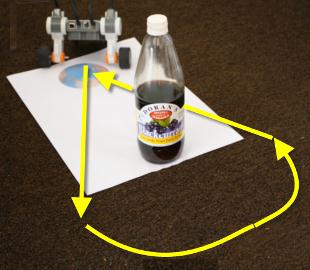Teacher/Mentor Notes - Around the Moon.
First we need an imaginary Earth. The Earth is called "The Blue Planet" because about 71% of its surface is covered by water, so I made my earth out of blue cardboard made circular by tracing around a CD - but you can use anything you like to represent Earth. For a smaller classroom, I include an A3 Earth/Moon image in ".pdf" format.
To represent the Moon I used a full 750 ml. soft drink bottle - it is heavy enough not to be moved too much if hit by an errant Robot, and small enough that it is not too big an obstacle for the robot to manoeuver around. Have you heard the old myth that the moon is made of green cheese? That myth goes back a long way. Cecil Adams quotes "John Heywood's Proverbes (1546): "The moon is made of a greene cheese," greene meaning new, unaged." In honour of that old rumour I usually use green (lime) cordial - but hey - no need to copy my whimsy, use whatever you like! To represent the Moon, I traced around the lid of a jar of locally made scrumptious Raspberry jam - but any jam will do! (-: I used green/yellow cardboard for the moon (green cheese?), but feel free to use whatever colour you like.
I mounted the "Earth" and "Moon" images on some black cardboard. I chose black because I had vague ideas of suggesting a future Challenge that would have involved the robots identifying the blue colour of the earth, and using that as a "stop signal" after a moon circuit - but so far we have not tried that Challenge with the classes I assist, so I can't recommend this variation from practice. See an example of the cardboard arena below. Note that the blue cardboard discolours when caught in the rain between classrooms - but that didn't cause any diminuation in student enthusiasm... (-:

How far apart you place your imitation "Earth" and "Moon" will depend on your classroom - in my original version of this Challenge on DrGraeme.net, I put the "Moon" and "Earth" about 60 cms (about 2 feet) apart because that fitted my room (and hence my comments in the DrGraeme.net version of this Challenge will match that distance). However in some classrooms this was too large, so in this version of these notes I have included a .pdf A3 image (click here) that includes Earth and Moon images that are about 23 cms/9 inches (from the edge of earth image to the edge of moon image) apart, and the instructions in these notes will match that distance. However the distance is not critical, if you want to choose a different distance that is fine.
My original intention regarding this challenge was to extend student abilities by showing them how to teach their robots to travel in a curve. My initial idea was that the robots would travel in a straight line, curve around the "moon" (in my case below a Dorans (est. 1834) bottle from the Huon Valley full of delicious Tasmanian Blackcurrant juice), and then travel back in a straight line to land on the "earth" image. The use of a full 750 ml. bottle (unlike the one pictured, I was thirsty) is a good idea as the robots will push most lighter objects away, and you will be continually putting the "Moon" back in place as errant robots attempt to demolish it.

Well, that was my original idea, but enthusiastic students have produced all sorts of fantastic and incredible variations which I (with my blinkered adult imagination) would never have even considered. You can see videos of some of these remarkable variations here.
To return to the tutorial series, click on 3 .